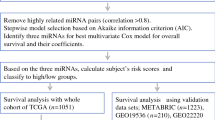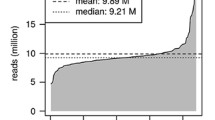Abstract
In the progression of cancer, cells acquire genetic mutations that cause uncontrolled growth. Over time, the primary tumour may undergo additional mutations that allow for the cancerous cells to spread throughout the body as metastases. Since metastatic development typically results in markedly worse patient outcomes, research into the identity and function of metastasis-associated biomarkers could eventually translate into clinical diagnostics or novel therapeutics. Although the general processes underpinning metastatic progression are understood, no clear cross-cancer biomarker profile has emerged. However, the literature suggests that some microRNAs (miRNAs) may play an important role in the metastatic progression of several cancer types. Using a subset of The Cancer Genome Atlas (TCGA) data, we performed an integrated analysis of mRNA and miRNA expression with paired metastatic and primary tumour samples to interrogate how the miRNA–mRNA regulatory axis influences metastatic progression. From this, we successfully built mRNA- and miRNA-specific classifiers that can discriminate pairs of metastatic and primary samples across 11 cancer types. In addition, we identified a number of miRNAs whose metastasis-associated dysregulation could predict mRNA metastasis-associated dysregulation. Among the most predictive miRNAs, we found several previously implicated in cancer progression, including miR-301b, miR-1296, and miR-423. Taken together, our results suggest that metastatic samples have a common cross-cancer signature when compared with their primary tumour pair, and that these miRNA biomarkers can be used to predict metastatic status as well as mRNA expression.






Similar content being viewed by others
Data availability
All data and scripts are publicly available
References
Alon U, Barkai N, Notterman DA, Gish K, Ybarra S, Mack D, Levine AJ (1999) Broad patterns of gene expression revealed by clustering analysis of tumor and normal colon tissues probed by oligonucleotide arrays. Proc Natl Acad Sci USA 96(12):6745–6750
Golub TR, Slonim DK, Tamayo P, Huard C, Gaasenbeek M, Mesirov JP, Coller H, Loh ML, Downing JR, Caligiuri MA, Bloomfield CD, Lander ES (1999) Molecular classification of cancer: class discovery and class prediction by gene expression monitoring. Science 286(5439):531–537
van ’t Veer LJ, Dai He, van de Vijver MJ, He YD, Hart AAM, Mao M, Peterse HL, van der Kooy K, Marton MJ, Witteveen AT, Schreiber GJ, Kerkhoven RM, Roberts C, Linsley PS, Bernards R, Friend SH (2002) Gene expression profiling predicts clinical outcome of breast cancer. Nature 415(6871):530–536
Noto K, Majidi S, Edlow AG, Wick HC, Bianchi DW, Slonim DK (2015) CSAX: characterizing systematic anomalies in expression data. J Comput Biol 22(5):402–413
Quinn TP, Nguyen T, Lee SC, Venkatesh S (2019) Cancer as a tissue anomaly: classifying tumor transcriptomes based only on healthy data. Front Genet 10:599
Iorio MV, Croce CM (2012) MicroRNA dysregulation in cancer: diagnostics, monitoring and therapeutics. A comprehensive review. EMBO Mol Med 4(3):143–159
Zhao Q, Shi X, Xie Y, Huang J, Shia B, Ma S (2015) Combining multidimensional genomic measurements for predicting cancer prognosis: observations from TCGA. Brief Bioinform 16(2):291–303
Garofalo M, Croce CM (2011) microRNAs: master regulators as potential therapeutics in cancer. Annu Rev Pharmacol Toxicol 51:25–43
Li L, Zhang J, Diao W, Wang D, Wei Y, Zhang C-Y, Zen K (2014) MicroRNA-155 and MicroRNA-21 promote the expansion of functional myeloid-derived suppressor cells. J Immunol 192(3):1034–1043 (Baltimore, Md.: 1950)
Armand-Labit V, Pradines A (2017) Circulating cell-free microRNAs as clinical cancer biomarkers. Biomol Concepts 8(2):61–81
Robert RJ, van den Braak C, Sieuwerts AM, Lalmahomed ZS, Smid M, Wilting SM, Bril SI, Xiang S, van der Vlugt-Daane M, de Weerd V, van Galen A, Biermann K, Han J, van Krieken JM, Kloosterman WP, Foekens JA, Martens JWM, IJzermans. JNM (2018) Confirmation of a metastasis-specific microRNA signature in primary colon cancer. Scientific Reports 8(1):5242
Li W, Chang J, Tong D, Peng J, Huang D, Guo W, Zhang W, Li J (2017) Differential microRNA expression profiling in primary tumors and matched liver metastasis of patients with colorectal cancer. Oncotarget 8(22):35783–35791
Lou W, Liu J, Gao Y, Zhong G, Chen D, Shen J, Bao C, Liang X, Pan J, Cheng J, Ding B, Fan W (2017) MicroRNAs in cancer metastasis and angiogenesis. Oncotarget 8(70):115787–115802
Christopher AF, Kaur RP, Kaur G, Kaur A, Gupta V, Bansal P (2016) MicroRNA therapeutics: discovering novel targets and developing specific therapy. Perspect Clin Res 7(2):68–74
Schrank Z, Khan N, Osude C, Singh S, Miller RJ, Merrick C, Mabel A, Kuckovic A, Puri N (2018) Oligonucleotides targeting telomeres and telomerase in cancer. Molecules 23(9):2267
Yan T, Zhu S, Zhang J, Lu G, Lv C, Wei Y, Luo M (2018) MicroRNA-944 targets vascular endothelial growth factor to inhibit cell proliferation and invasion in osteosarcoma. Mol Med Rep 18(6):5221–5228
Shibata C, Otsuka M, Kishikawa T, Yoshikawa T, Ohno M, Takata A, Koike K (2013) Current status of miRNA-targeting therapeutics and preclinical studies against gastroenterological carcinoma. Mol Cell Ther 1:5
de Almeida RT, David C, de Almeida SST (2017) The race of 10 synthetic rnai-based drugs to the pharmaceutical market. Pharm Res 34(7):1339–1363
Head SR, Kiyomi Komori H, LaMere SA, Whisenant T, Van Nieuwerburgh F, Salomon DR, Ordoukhanian P (2014) Library construction for next-generation sequencing: overviews and challenges. BioTechniques 56(2):61 passim
Weinstein JN, Collisson EA, Mills GB, Shaw KM, Ozenberger BA, Ellrott K, Shmulevich I, Sander C, Stuart JM (2013) The cancer genome atlas pan-cancer analysis project. Nat Genet 45(10):1113–1120
Chen F, Zhang Y, Varambally S, Creighton CJ (2019) Molecular correlates of metastasis by systematic pan-cancer analysis across the cancer genome atlas. Mol Cancer Res 17(2):476–487
Chu A, Robertson G, Brooks D, Mungall AJ, Birol I, Coope R, Ma Y, Jones S, Marra MA (2016) Large-scale profiling of microRNAs for the cancer genome atlas. Nucleic Acids Res 44(1):e3–e3
Colaprico A, Silva TC, Olsen C, Garofano L, Cava C, Garolini D, Sabedot TS, Malta TM, Pagnotta SM, Castiglioni I, Ceccarelli M, Bontempi G, Noushmehr H (2016) TCGAbiolinks: an R/Bioconductor package for integrative analysis of TCGA data. Nucleic Acids Res 44(8):e71–e71
Anders S, Huber W (2010) Differential expression analysis for sequence count data. Genome Biol 11:R106
Subramanian A, Tamayo P, Mootha VK, Mukherjee S, Ebert BL, Gillette MA, Paulovich A, Pomeroy SL, Golub TR, Lander ES, Mesirov JP (2005) Gene set enrichment analysis: a knowledge-based approach for interpreting genome-wide expression profiles. Proc Natl Acad Sci 102(43):15545–15550
Liberzon A, Subramanian A, Pinchback R, Thorvaldsdottir H, Tamayo P, Mesirov JP (2011) Molecular signatures database (MSigDB) 3.0. Bioinformatics 27(12):1739–1740
Liberzon A, Birger C, Thorvaldsdóttir H, Ghandi M, Mesirov JP, Tamayo P (2015) The molecular signatures database hallmark gene set collection. Cell Syst 1(6):417–425
Quinn T, Tylee D, Glatt S (2017) exprso: an R-package for the rapid implementation of machine learning algorithms. F1000Research 5:2588
Friedman J, Hastie T, Tibshirani R (2010) Regularization paths for generalized linear models via coordinate descent. J Stat Softw 33(1):1–22
Liaw A, Wiener M (2002) Classification and regression by randomForest. R News 2(3):18–22
Meyer D, Dimitriadou E, Hornik K, Weingessel A, Leisch F (2017) e1071: Misc Functions of the Department of Statistics, Probability Theory Group (Formerly: E1071), TU Wien
Bliss CI, Fisher RA (1953) Fitting the negative binomial distribution to biological data. Biometrics 9(2):176–200
Robinson MD, McCarthy DJ, Smyth GK (2010) edgeR: a Bioconductor package for differential expression analysis of digital gene expression data. Bioinformatics 26(1):139–140
Wilcoxon F (1945) Individual comparisons by ranking methods. Biom Bull 1(6):80–83
Benjamini Y, Hochberg Y (1995) Controlling the false discovery rate: a practical and powerful approach to multiple testing. J R Stat Soc Ser B 57(1):289–300
Sticht C, De La Torre C, Parveen A, Gretz N (2018) mirwalk: An online resource for prediction of microrna binding sites. PLoS ONE 13(10):e0206239
Fort RS, Mathó C, Oliveira-Rizzo C, Garat B, Sotelo-Silveira JR, Duhagon MA (2018) An integrated view of the role of miR-130b/301b miRNA cluster in prostate cancer. Exp Hematol Oncol 7:10
Cheng D, He H, Liang B (2018) A three-microRNA signature predicts clinical outcome in breast cancer patients. Eur Rev Med Pharmacol Sci 22(19):6386–6395
Hamilton MP, Rajapakshe K, Hartig SM, Reva B, McLellan MD, Kandoth C, Ding L, Zack TI, Gunaratne PH, Wheeler DA, Coarfa C, McGuire SE (2013) Identification of a pan-cancer oncogenic microRNA superfamily anchored by a central core seed motif. Nat Commun 4:2730
Shan Xia, Wen Wei, Zhu Danxia, Yan Ting, Cheng Wenfang, Huang Zebo, Zhang Lan, Zhang Huo, Wang Tongshan, Zhu Wei, Zhu Yichao, Zhu Jun (2017) miR 1296–5p inhibits the migration and invasion of gastric cancer cells by repressing ERBB2 expression. PLOS ONE 12(1):e0170298
Phan B, Majid S, Ursu S, de Semir D, Nosrati M, Bezrookove V, Kashani-Sabet M, Dar AA (2016) Tumor suppressor role of microRNA-1296 in triple-negative breast cancer. Oncotarget 7(15):19519–19530
Guan G, Zhang D, Zheng Y, Wen L, Duojiao Y, Yanqing L, Zhao Y (2014) microRNA-423-3p promotes tumor progression via modulation of AdipoR2 in laryngeal carcinoma. Int J Clin Exp Pathol 7(9):5683–5691
Riquelme I, Tapia O, Leal P, Sandoval A, Varga MG, Letelier P, Buchegger K, Bizama C, Espinoza JA, Peek RM, Araya JC, Roa JC (2016) miR-101-2, miR-125b-2 and miR-451a act as potential tumor suppressors in gastric cancer through regulation of the PI3k/AKT/mTOR pathway. Cell Oncol 39(1):23–33
Maltseva DV, Galatenko VV, Samatov TR, Zhikrivetskaya SO, Khaustova NA, Nechaev IN, Shkurnikov MU, Lebedev AE, Mityakina IA, Kaprin AD, Schumacher U, Tonevitsky AG (2014) miRNome of inflammatory breast cancer. BMC Res Notes 7(1):871
Funding
Not applicable.
Author information
Authors and Affiliations
Contributions
SCL and TPQ reviewed the literature, designed the project, performed the analyses, and drafted the manuscript. AQ reviewed the literature and helped draft the manuscript. All authors edited and approved the final manuscript.
Corresponding author
Ethics declarations
Conflict of interest
The authors declare that they have no conflict of interests
Additional information
Publisher's Note
Springer Nature remains neutral with regard to jurisdictional claims in published maps and institutional affiliations.
Electronic supplementary material
Below is the link to the electronic supplementary material.
Rights and permissions
About this article
Cite this article
Lee, S.C., Quinn, A., Nguyen, T. et al. A cross-cancer metastasis signature in the microRNA–mRNA axis of paired tissue samples. Mol Biol Rep 46, 5919–5930 (2019). https://doi.org/10.1007/s11033-019-05025-w
Received:
Accepted:
Published:
Issue Date:
DOI: https://doi.org/10.1007/s11033-019-05025-w




